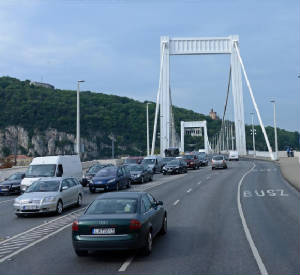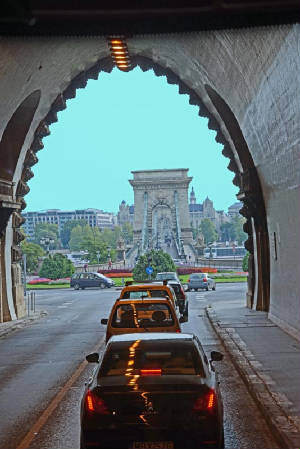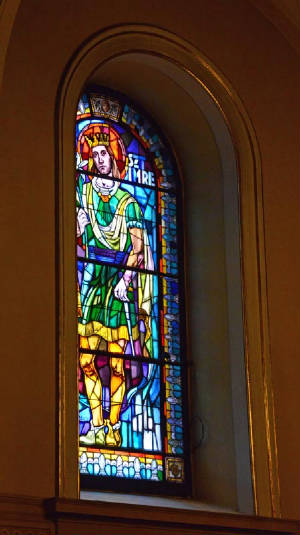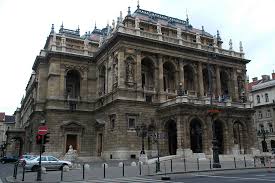 |
Click here for a video of Hero’s Square. A 180 degree view of this famous landmark.
The Art Gallery Building was constructed in 1895 and renovated in 1992-94.
The Zoo and the Szechenyi Bath (spa) and swimming pool were also located here.
Vajdahunyad Castle incorporates some of the finest buildings in the historical Hungary into a single eclectic palace featuring styles from the Middle Ages to the 18th century: Romanesque, Gothic Renaissance, Baroque buildings, from the Romanesque church of the village Jak to the Baroque palace of Prince Paul Esterhazy I. It was built between 1896 and 1908 as part of the Millennial Exhibition which celebrated the 1000 years of Hungary since the Hungarian Conquest of the Carpathian Basin in 895. Its an exhibition Hall vs. a real castle where kings lived.
The Dohány Street Synagogue also known as The Great Synagogue Synagogue, is a historical building in Erzsébetváros, the 7th district of Budapest, Hungary. It is the largest synagogue in Europe and one of the largest in the world. It seats 3,000 people and is a centre of Neolog Judaism.
The synagogue was built between 1854 and 1859 in the Moorish Revival style, with the decoration based chiefly on Islamic models from North Africa and medieval Spain. The synagogue’s Viennese architect, Ludwig Förster, believed that no distinctively Jewish architecture could be identified, and thus chose “architectural forms that have been used by oriental ethnic groups that are related to the Israelite people, and in particular the Arabs”.The interior design is partly by Frigyes Feszl.
The Dohány Street Synagogue complex consists of the Great Synagogue, the Heroes’ Temple, the graveyard, the Memorial and the Jewish Museum, which was built on the site on which Theodore Herzl’s house of birth stood. Dohány Street itself, a leafy street in the city center, carries strong Holocaust connotations as it constituted the border of the Budapest Ghetto. Adjacent to it is the Adjoining the The Central Synagogue (Nagy Zsinagóga) is the Weeping Willow Memorial which lies in the courtyard to the rear which houses the Synagogue’s garden of remembrance. Designed by Imre Varga, the weeping willow is a magnificent Holocaust memorial. The names of some 4000 Jewish families who were murdered are listed on the leaves and an inscription reads ‘Whose agony is greater than mine’. This is no where near the estimated total of 15,000 Jews from Budapest that were killed. I have seen estimates that range from 180,000 to 550,00 Hungarian Jews that were killed. I doubt if we will ever know.
This stainless steel sculpture looks like a sallow broad-leaved willow. The names of many of the victims of the Holocaust are engraved on the leaves of this tree.

We cross the new Elizabeth Bridge constructed in 1964
The Buda Palace. Remember Buda and Pest are two separate cities, separated by the Danube River. This palace was built in the 13 century but has been continually added on to right up into the 20 century.
In Hungary, there are two main legends that surround a mythical bird called the “Turul“, which is attributed to shaping the fate of the Hungarians. The bird is usually described as a giant eagle or a falcon with a sword in it’s talons.
The first legend of the Turul tells the story of Princess Emese, consort of a Scythian king, who once had a dream in which a Turul appeared to her. In this dream, a crystal-clear stream started to flow from her, and as it moved Westward, it grew into a mighty river. This dream represented her symbolic impregnation by the Turul, and meant that she would give birth to a line of great rulers. Emese later gave birth to Álmos, who was the father of Árpád, the great leader of the Magyars and founder of Hungary.
In the second legend, the leader of the Hungarian tribes had a dream in which eagles attacked their horses and a Turul came and saved them. This symbolized that they had to migrate, and when they did so, the Turul helped them to show the way and eventually led them to the land that became Hungary. The most prominent is the bronze Turul statue situated on the railing of Buda Castle, which was sculpted by Gyula Donath in 1905.
This tunnel runs from the Old Chain Bridge under Gillert Hill and the Buda Palace.

| Through the bus window – pardon the reflection |
Matthias Church is a Roman Catholic church located in front of the Fisherman’s Bastion at the heart of Buda’s Castle District. According to church tradition, it was originally built in Romanesque style in 1015, although no archaeological remains exist.The current building was constructed in the florid late Gothic style in the second half of the 14th century and was extensively restored in the late 19th century. This church has seen it’s share of history. It was overrun by the Ottomans in 1526 and converted to a Mosque. The inner furnishings were stripped and the wall frescos whitewashed. Two beautiful candelabras were removed and still remain in Istanbul, Turkey. In 1686 the Ottomans were “removed” by Christian solders and the church again reverted to being the Church of Our Lady or more commonly known as the King Matthias Church.
Tomb of King Béla III and Anne de Châtillon – the remains of the royal couple were brought here from Székesfehérvár Cathedral in 1860
The Hungarian Parliament Building was completed in 1904. It has a commanding view of the Danube.
About one thousand people were involved in construction, during which 40 million bricks, half a million precious stones and 88 lb of gold were used. During the communist regime a red star perched on the top of the dome, but was removed in 1990. It is 268 879 ft long and 404 ft wide. Its interior includes 10 courtyards, 13 passenger and freight elevators, 27 gates, 29 staircases and 691 rooms (including more than 200 offices). With its height of 315 ft, it is one of the two tallest buildings in Budapest, along with Saint Stephen’s Basilica.
Saint Stephen’s Basilica. The church is named after Saint Stephen I of Hungary, the first King of Hungary, whose incorruptible right hand is housed in the reliquary.
This is the most important church building in Hungary, one of the most significant tourist attractions and the third highest building in Hungary.315 ft) – this equation symbolises that worldly and spiritual thinking have the same importance. According to current regulations there cannot be taller building in Budapest than 315 ft. It has a width of 55 180 ft, and length of 287 ft. It was completed in 1905 after 54 years of construction, according to the plans of Miklós Ybl, and was completed by József Kauser. Much of this delay can be attributed to the collapse of the dome in 1868 which required complete demolition of the completed works and rebuilding from the ground up. Never enough time to do it right, but always enough time to do it over!
These girls were doing “Yoga Poses?” in front of Saint Stephen’s Basilica. Photo is strictly for scenic value!
For a video tour of the dome of the is Basilica, click here

A mummified right hand as a religious artifact? Here is the story in a nutshell. Stephen was buried in Székesfehérvár on August 15, 1038, in a sarcophagus that is more or less intact although empty. The body was later reburied in the lower underground catacomb out of fear of possible disturbances of the grave. It was at that time that the hand was removed from the rest of the body because of its alleged miraculous properties. It was taken to the treasury of the basilica from where the man who was in charge of guarding the treasury stole it and hid it on his estate in the County of Bihar/Bihor, today Romania.
During the reign of King László I the Right Hand was discovered, but the king forgave the thief and in fact erected a monastery on the spot. The village today is called Szentjobb/Siniob. It was here that pilgrims came to pray in front of the king’s Right Hand, which was allegedly capable of performing miracles.
It was only in the fifteenth century that the Right Hand was moved from Szentjobb/Siniob back to Székesfehérvár. During the Turkish occupation, however, around 1590, it ended up in Ragusa (Dubrovnik) and was held by Dominican friars. The official church story doesn’t divulge any details of its mysterious reappearance in Ragusa.
There are two chronicles that mention the burial and subsequent reburial of the body. Both report that the Right Hand was removed to the County of Bihor where it was found by King László on May 30, 1084. According to the chronicler Hartvik, bishop of Győr (1116), at that time the Hand had St. Stephen’s ring on it which definitely identified it as belonging to the saintly king. The alleged Right Hand today has no ring on it or any sign that there ever was a ring it that was later removed.
There is another problem. All contemporary pictures show Stephen buried lying on his back, his hands alongside his body with open fists. Today’s Right Hand, as you can see on the picture, is tight-fisted. But that is not all. The official coat-of-arms of the town of Szentjobb/Siniob shows not just the hand but the whole arm bent at the elbow. Since the town came into being as a result of the presence of the Holy Right Hand, one must assume that the coat-of-arms is an accurate depiction of the actual state of the relic at the time.
And with that missing arm we come to moer of Stephen’s body parts wandering around in central Europe and the Balkans. It is assumed that the upper arm was removed in 1370 when Louis the Great (Nagy Lajos) also became the King of Poland. It was customary to send important relics as symbols of steadfast friendship and devotion to men, country, or cause. The Franciscans of the city of Lviv (Lvov, Lemberg) hold that at one time they were the ones who were entrusted with guarding the holy relic of St. Stephen’s upper arm for which King Jan Kazimierz II ordered a jeweled case.
The lower arm was sent by King Sigismund (Zsigmond) to Albert V at the time of his daughter’s marriage to the Prince (1411), sealing a personal union between Hungary and the Holy Roman Empire. For a while it was held in the St. Stephen Basilica in Vienna, named after St. Stephen the Martyr, and later was moved to the Schatzkammer of the Hofburg. But there is a bit of a problem with this lower arm. When the bone was sent to Hungary for the millennial celebrations in 2000 and was put on display, it was discovered that it is not part of an arm. Rather, it is the fibula of a right leg.
In addition, there are several small pieces of Stephen’s skull cap (calvarium) that are held in various places, including Székesfehérvár. No one has ever tried to find out whether these pieces of Stephen’s skeleton belong to the same man or not. Since the 1950s the Right Hand was examined three times but not scientifically. The first time the Right Hand seemed to have developed mildew which needed to be removed. The physician who attended to it added some conserving material to the rest of the hand and that was all. In 1988 another physician examined it, but the only thing he came up with was that there was no sign of metal ever touching the hand because otherwise there should have been some observable discoloration. He also noticed that it was a relatively small hand. The third time it was Miklós Réthelyi, professor of anatomy and later minister in the second Orbán government, who took a look at it, but he came up with nothing new. A DNA examination would only make sense if we could find a descendant of Stephen, but even if that were possible I doubt that either the Hungarian Catholic Church or the current Hungarian government would be too keen on such a scientific investigation.
As for the multiplication of St. Stephen relics. As late as 2004, a piece of Stephen’s upper arm that ended up in Poland was given by Franciszek Cardinal Macharski, Archbishop of Cracow, to the Hungarian chapel of the Divine Mercy Sanctuary in Cracow. In 2009 Balázs Bábel, Archbishop of Kalocsa, gave a golden reliquary to Robert Bezák, Archbishop of Nagyszombat/Trnava, in which there is a very small bone of the Right Hand. In the same year a small piece of St. Stephen’s skull was sent to a church in the Subcarpathian part of Ukraine. In 2006, Cardinal Péter Erdő, the head of the Hungarian Catholic Church, gave a piece from St. Stephen’s rib to Alojz Tkáč. Looks like there was a piece of St. Stephen for everyone. This information was determined from an Internet search. The Skunk is grateful that he did not have 150 kids. We could only guess what would be on display. Sorry if I gored anyone’s sacred cow.
 |
It is a richly-decorated building and is considered one of the architect’s masterpieces. Ornamentation includes paintings and sculptures by leading figures of Hungarian art including Bertalan Székely Mór Than and Károly Lotz. Although in size and capacity it is not among the greatest, in beauty and the quality of acoustics the Budapest Opera House is considered to be amongst the finest opera houses in the world.
The auditorium holds 1,261 people. It is horseshoe shaped and – according to measurements done in the 1970s by a group of international engineers – has the third best acoustics in Europe after La Scala in Milan and the Palais Garnier in Paris. Although many opera houses have been built since, the Budapest Opera House is still among the best in terms of the acoustics.
In front of the building are statues of Franz Liszt and Ferenc Erkel. Liszt is the best known Hungarian composer.
Two of these Sphinx’s guard the main entrance.
Yes, I had to pay to tour and again for my camera to take photos. Double whammy! But it was worth it.
This beautiful old building was sitting in the downtown area waiting for someone to come up with the money to renovate it. Note the boarded up windows.
Having worked up an appetite in the Opera, our next stop was a coffee house to coffee and pastry. The first floor contained a book store and up the escalator was the coffee house. I asked what the building had originally been and was told it always was a bookstore and coffee house.
Answer! None! They are all reflections of a center chandler hanging between strategically placed mirrors on each side of the coffee house.
Beautiful floral design in my cappuccino that held together right down to the bottom of the cup. No, I did not stir it!
Other miscellaneous photos taken as we were walking and driving around Budapest. There are so many sight to be seen and photographed, I believe you could spend a month and still not see everything.